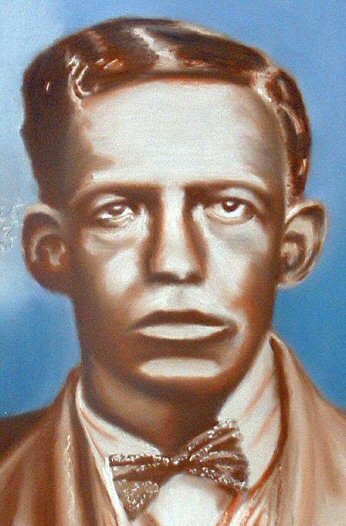
Painting © 2004 Loz
Arkle
Website
© Copyright 2000-2011 Alan White - All
Rights Reserved
Site optimised for Microsoft Internet Explorer
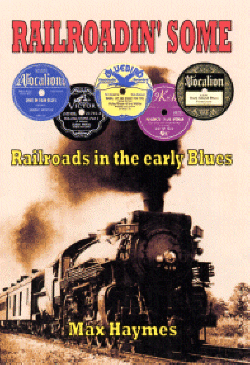
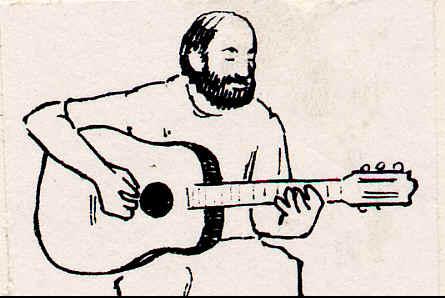

"KATY’S
AT THE STATION. SANTA FE IS IN THE YARD"
(on the rail trail of Bessie Tucker
- Queen of the Texas Moaners)
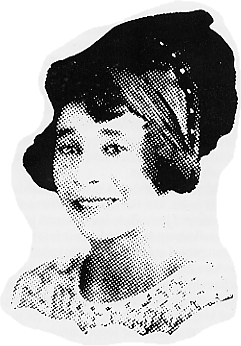 Despite
being one of the finest rural or downhome female blues singers ever to record,
along with Lucille Bogan, Memphis Minnie, and Pearl Dickson, we know precious
little about Bessie Tucker. Even though her recorded legacy (1928-1929) has been
made available via C.D. on the indefatigable Document label, (see discography at
end of this article). The one exception is "Pick On Me Blues" (Vi
unissued) from her Oct. 17th. session in 1929, which remains untraced. A young
and very attractive near-white looking singer. Tucker possessed a powerful
voice, a kind of female equivalent to Charlie Patton, which goes back to the
very roots of the Blues. Like Patton, her hollered and deep moaning vocals belie
the slight physical stature of the singer. Apart from a tenuous reference to
both Bessie Tucker and Ida Mae/May Mack, by Whistlin' Alex Moore in a 1960
interview with Paul Oliver; nothing else has been discovered despite long and
fruitless searches by other collectors as well as Oliver himself. Ida May Mack,
only a slightly less powerful singer, had shared both Bessie's 1928 sessions for
Victor and also her accompanist, K.D.Johnson. Moore, a superb pianist from
Dallas, related that both Tucker and Mack are "...tough cookies, don't mess
with them..." in the present tense; in 1960. This quite reasonably led
Oliver to suppose the two singers "were still around" at that time.
However, in a further conversation with the barrelhouse pianist in 1972, Moore
"... could not recall either name." He was also "extremely vague
about both women" and Paul Oliver rightly suspected that Alex Moore
"had heard their records and drawn his own conclusions." This included
Moore's comment that "Bessie did time in the pen." (1). A cursory
listen to her "Penitentiary" (1928) could not fail to convince the
listener of this apparent fact.
Despite
being one of the finest rural or downhome female blues singers ever to record,
along with Lucille Bogan, Memphis Minnie, and Pearl Dickson, we know precious
little about Bessie Tucker. Even though her recorded legacy (1928-1929) has been
made available via C.D. on the indefatigable Document label, (see discography at
end of this article). The one exception is "Pick On Me Blues" (Vi
unissued) from her Oct. 17th. session in 1929, which remains untraced. A young
and very attractive near-white looking singer. Tucker possessed a powerful
voice, a kind of female equivalent to Charlie Patton, which goes back to the
very roots of the Blues. Like Patton, her hollered and deep moaning vocals belie
the slight physical stature of the singer. Apart from a tenuous reference to
both Bessie Tucker and Ida Mae/May Mack, by Whistlin' Alex Moore in a 1960
interview with Paul Oliver; nothing else has been discovered despite long and
fruitless searches by other collectors as well as Oliver himself. Ida May Mack,
only a slightly less powerful singer, had shared both Bessie's 1928 sessions for
Victor and also her accompanist, K.D.Johnson. Moore, a superb pianist from
Dallas, related that both Tucker and Mack are "...tough cookies, don't mess
with them..." in the present tense; in 1960. This quite reasonably led
Oliver to suppose the two singers "were still around" at that time.
However, in a further conversation with the barrelhouse pianist in 1972, Moore
"... could not recall either name." He was also "extremely vague
about both women" and Paul Oliver rightly suspected that Alex Moore
"had heard their records and drawn his own conclusions." This included
Moore's comment that "Bessie did time in the pen." (1). A cursory
listen to her "Penitentiary" (1928) could not fail to convince the
listener of this apparent fact.
Even though care needs to be taken in search of the truth, when listening to the lyrics of blues records - in Bessie Tucker's case it really is all we have to go on. But I am putting forward a theory concerning her possible origins and subsequent movements by concentrating on the railroads featured in her blues. This approach gives at least one element of certainty to any details that can be gleaned from the routes of both major and lesser railroads which are familiar to the singer, and the cities that they served. One of Bessie's songs included what could well be the only reference to the Texas Midland RR. in the Blues.
"Katy's
at the station, Santa Fe is in the yard;
Mmmmmmmm, Santa Fe is in the yard.
I would catch that T.P.. if this Midland's got me barred." (2)
This
having a choice of railroads is a recurring theme in the Blues, which seems to
have first been captured on a record by a fine vaudeville-blues singer, Ethel
Ridley, in 1923.
"No.
7's in the station. No. 11 in the yard;
No. 7 in the station. No. 11 in the yard.
Gonna leave this town if I have to ride the rods." (3)
Three
years further on and celebrated Texas singer Victoria Spivey put down her
"Santa Fe Blues" including these lines:
"81's
in the yard, 82's out on the road;
81 's in the yard an' 82's out on the road.
81's takin' my livin', 82's leavin' me out of doors." (4)
Spivey's
closing words indicating she was referring to a passenger train woman. Leroy
Carr - would include yet another variant on his "Mean Old Train Blues"
about a year prior to the Bessie Tucker recording. The Texas Midland started
life at the end of 1892 and owned by Hetty Green then the richest woman in the
U.S. Reed informs us that she was one of only 4 female railroad bosses in Texas.
Having bought part of another railroad that had gone bust she added this to her
own company and handed it over to her only son, E.H.R. Green. This was partly to
protect her holdings but primarily to give him "a chance to show what was
in him." (5). E.H.R. Green was highly successful in this venture and had
his headquarters at Terrell. Becoming a major road for cotton in Texas, he only
sold the Texas Midland, in 1928, when his ageing mother needed help to run her
other financial affairs. The buyer was the Texas & New Orleans RR.
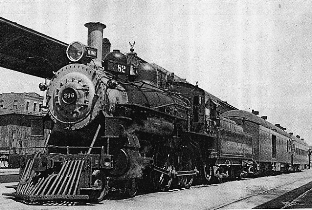 Known
by railroad workers as "the Midland", the T.M. ran from Ennis, 30-odd
miles south of Dallas, in a north-easterly direction through Terrell, Greenville
and on to Paris, meeting the Santa Fe whose own Texas main line ran down through
Dallas to Galveston on the Gulf of Mexico. This route was similar to that of the
Missouri-Kansas-Texas (M-K-T) or 'the Katy' which also served the seaport. The
Santa Fe also ran through Greenville, Tex. and the Katy crossed it at that point
on the way from Mineola to Denison which was then the headquarters for the
M-K-T. Its rails would take it northwards to St. Louis with a branch off to
Kansas City, Mo.
Known
by railroad workers as "the Midland", the T.M. ran from Ennis, 30-odd
miles south of Dallas, in a north-easterly direction through Terrell, Greenville
and on to Paris, meeting the Santa Fe whose own Texas main line ran down through
Dallas to Galveston on the Gulf of Mexico. This route was similar to that of the
Missouri-Kansas-Texas (M-K-T) or 'the Katy' which also served the seaport. The
Santa Fe also ran through Greenville, Tex. and the Katy crossed it at that point
on the way from Mineola to Denison which was then the headquarters for the
M-K-T. Its rails would take it northwards to St. Louis with a branch off to
Kansas City, Mo.
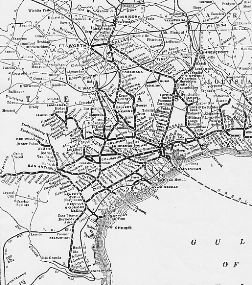
Bessie
could catch the T.P., otherwise the Texas & Pacific, as an alternative if
indeed "this Midland's got me barred" or it prevented her from bumming
a ride once she got to Terrell. She could travel down from Dallas, where she
recorded "Katy Blues", to Mineola where she could change over to the
Katy to get to Greenville. It seems that Greenville, Texas, is the only location
near Dallas which afforded Bessie Tucker the 'luxury' of hoboing any one of the
4 railroads to get there; as she boasts in "Katy Blues". Nor was she a
stranger to this method of travelling as another of her recordings indicates. On
"The Dummy" made at her first session in Memphis she hollers out a
graphic description of riding illegally in a box car and getting caught by the
railroad "police" employed to keep hoboes off the trains.
These
railroad employees were generally whites and often unsympathetic if not sometime
downright brutal.
"Now,
when I got on the Dummy, didn't have no fare;
The police asked me what I was doin' on there.
I got on the Dummy, mama didn't have no fare;
An' the police asked me, what I was doin' on there."
"Well,
he caught me by the hand he led me to the door;
He hit me cross the head with a two-by-four.
Caught me by the hand, led me to the door;
An' he hit me cross the head with a two-by-four."(6)
In
the 1920s lumber was still a major force in Southern industry and indeed all of
the railroads referred to by Bessie Tucker had logging interests at that time.
Temporary lines were built deep into the piney woods and were known as 'dummy
lines'. The term also included the trains that ran on them; some of which
eventually carried passengers as well
as lumber. Logging camps were set up at the railhead
with a commissary store and often a
barrelhouse. This was to keep the predominantly black
workers from 'straying' off the job
at the weekend. A piano would be supplied by the
company and blues singers brought in
to entertain. As well as liquor and gambling there were
also prostitutes to help the workers
spend their money. Bessie Tucker, like Lucille Bogan,
was thought to have been working
"Well,
I ain't no pullet, I'm a real young hen;
If you come by here once, you'll come back again.
I ain't no pullet, boys, I'm a real young hen.
If you come by once, you'll come back again." (7)
From
the same session as "The Dummy", another side "My Man Has Quit
Me" includes
the following verse which is usually of a sexual nature
sung by male artists such as Skip
James on his "Cypress Grove Blues" in 1931.
But Bessie changes the 'answering line' to
make a unique and personal reference to a failed
relationship with a railroad man who
worked on the Santa Fe.
"The
sun goin' down, know what you promised me;
Lord, the sun goin' down, know what you promised me.
A ticket on the Katy, pass on the Santa Fe." (8)
Only
rich and influential individuals in politics and industry, or railroad
employees, got
railroad passes. The first group would feature very few
blacks and so they would fall into
the second; which would include Bessie Tucker's man who
has "quit her". A pass lasted
usually for 12 months and would be very handy for her
to make frequent trips on the Santa
Fe from Greenwood to Dallas - either to work as a
prostitute or to sing along Central
Tracks down on Elm Street for nickels and dimes. (Footnote
1). But a ticket seems to
imply a one-off journey; and I can't help thinking that
the two were combined in this
instance for a slightly longer trip via both the Katy
and the Santa Fe. This presumably
would take her to where her partner lived.
Yet
another side from Bessie Tucker's first 1928 session seems to give a good idea
of this
location; somewhere along the Fort Worth & Denver
City Railway which connected with
the Katy at both Henrietta and Wichita Falls. Having
got both a ticket and a pass she could
travel to Paris from Greenwood using the latter on the
Santa Fe. Then her free ticket
would take her on the Katy from Paris travelling
westward through Whitesboro and
Gainesville to Henrietta and terminating at Wichita
Falls. But like so many affairs of the
heart, Bessie's ended in tears and she looks out of her
back door with blurred vision at the
tracks of the Fort Worth & Denver (the "Denver
road"), which she knows took her man
away and now seems to be calling her to go back home
and possibly pick up with an old
flame in Greenville. But in her emotional confusion she
is unsure of what to do next; now possessing neither a ticket or a pass.
"Fort
Worth an' Denver come through these parts today;
Mmmmmmmmm, come through these parts today.
Fort Worth an' Denver took my good man away."
"Fort
Worth an' Denver come back an' get poor me;
Mmmmmmmmm, come back an' get poor me.
I want you to take me to my old time used-to-be."
"I've
got the Fort Worth an' Denver Blues, don't know which place to go;
Mmmmmmmmm, don't know which place to go.
I hear that Fort Worth an' Denver, it call in my back door."
As
is typical in these situations her heartbreak and confusion turn to anger. But
it is not
directed at her departing lover or even at the railroad
that "took my good man away". She
rounds on the 'evil' women in her neighbourhood one of
whom is presumably the reason
why she has been abandoned. But she does not want any
repercussions while she is still in
Henrietta (or Wichita Falls) so she de-personalises the
situation by implying a different
locality. Her man now catches the Katy, which of course
connected with these towns,
while she picked up the Santa Fe, which did not. The
nearest such depot served by both of
these railroads would be at Gainesville about 60 miles
directly north of Fort Worth, a
similar distance east of Henrietta and approximately 75
miles from Wichita Falls. In her
fury and frustration at not knowing her new female
rival she accuses all the women of
running off with her man.
"Well, he caught the
Katy, I caught that Santa Fe;
Mmmmmmmmm, I caught the Santa Fe.
All you women can say: "Your good man left town with me"."
Spoken: "Lord, these women so
evil." (9) (Footnote 2)
Conclusion
Known
facts
1.
Bessie Tucker recorded in Memphis & Dallas over a 14 month period in 1928
and
1929.
2. She sang in the style of Texas singers like Texas Alexander, Victoria Spivey
and Texas Bill Day.
3. She sang about railroads that all served E.Texas and Dallas in particular.
4. She was recalled by Dallas pianist Whistlin' Alex Moore in 1960 (along with
Ida May Mack). But he had no remembrance of her in 1972.
It can be assumed with almost 100% certainty that Bessie Tucker was from the Dallas area of East Texas and was living there in the late 1920s. But since no leads have ever been found in Dallas itself regarding this blues singer, it must be presumed she lived in a town, probably within a 50-mile radius of the city. This takes in Greenville, Tex. and Fort Worth.
5.
In the late 1920s, Greenville was served by 3 of the 4 roads in Bessie's
"Katy Blues". The exception being the T, & P.
6. Greenville could be reached travelling from Dallas on the T. & P. to
Mineola where the Katy would complete the journey.
7. Greenville could be reached from Dallas travelling to Terrell on the T. &
P. and changing to the Texas Midland to complete the journey.
8. Greenville could be reached direct from Dallas by both the Katy and the Santa
Fe.
So
evidence would seem to point to Greenville, Tex. being an extremely likely
location for Bessie Tucker in the late 1920s.
9.
Bessie refers to a relationship with a man, on her "My Man Has Quit
me", who has promised her a railroad pass on the Santa Fe as well as buying
her a ticket on the Katy.
10. To obtain a railroad pass meant being a railroad employee, or a person of
power, influence and money.
11. In the South during the 1920s, it was extremely rare to find men of
high-power status (such as an owner of a railroad, steel works, or a leading
politician) who was an African American.
12. A majority of manual workers on Southern railroads were black, in the 1920s.
13. Bessie sings of living next to the tracks on her "Fort Worth &
Denver Blues".
This
undoubtedly makes Bessie's partner a railroad employee and working on the
Atchison, Topeka & Santa Fe Railway (the Santa Fe), For Bessie to make use
of both the pass, and the ticket on the Katy for a single journey from
Greenville, there was only one option. She had to take the Santa Fe from
Greenville to Paris, Tex., nearly 45 miles away, and then use her ticket on the
Katy travelling westward to Henrietta or Wichita Falls - both cities being
served by the F.W.& D.C. Railway Company. At that time the Katy terminated
at Wichita Falls.
Did she hobo her way back to Greenville and her old time used-to-be? Or did she seek pastures afresh in Fort Worth or somewhere outside Texas? We may never know. But the cities of Wichita Falls, Henrietta, and Greenville, could well turn up some more details about the superb "Queen of the Texas Moaners" - Bessie Tucker.
Footnote
1:
Central Tracks, named after the Houston &Texas Central which ran down this
street, was a famous black section of town
where many blues singers congregated. It was here that
Blind Lemon Jefferson was discovered by pianist/talent scout Sam Price in
1925, prior to Lemon's record debut for Paramount.
Footnote
2:
Several alternate takes of Bessie Tucker records have survived including
"Katy Blues", "My Man Has Quit Me" and "Fort Worth
& Denver Blues". However, in these cases they have identical lyrics to
those quoted in this article.
Notes
1.
Oliver Paul.
Notes to "Bessie Tucker & Ida Mae Mack"
(1928). L.P. Magpie PY 1815. 1979.
2.
"Katy Blues"-Tk.2.
Bessie Tucker vo.; K.D. Johnson pno.; Jessie Thomas gtr.; unk. bbs.
10/8/29. Dallas, Tex.
3.
"Alabama Bound Blues"
Ethel Ridley vo.; Leroy Tibbs pno. 23/6/23. New York City.
4.
"Santa Fe Blues"
Victoria Spivey vo.; John Erby pno. 12/8/26, New York City.
5.
Reed S.G.
"A History Of The Texas Railroads." Arno Press. New York. 1981.
(Rep.). 1st. pub. 1941.
6. "The Dummy"
Bessie Tucker vo.; K.D. Johnson pno
29/8/28. Memphis, Tenn
7. Ibid.
8. "My Man Has Quit Me"-Tk. 1.
Bessie Tucker vo.; K.D. Johnson pno.
29/8/28. Memphis, Tenn.
9.
"Fort Worth & Denver Blues"
Bessie Tucker vo., speech; K.D. Johnson pno
-Tk-1 29/8/28. Memphis, Tenn.
Discography
1.
"Bessie Tucker" (1928-1929).
Document DOCD-5070. 1991.
2. "Victoria Spivey" Vol.1.
Document DOCD-5316 1995
(1926-1927).
3.
"Female Blues-The Remaining Titles"
Vol.1 (1922-1927)
Jazz
Perspectives JPCD-15262.
Copyright © 2002 Max Haymes.
All rights reserved.




